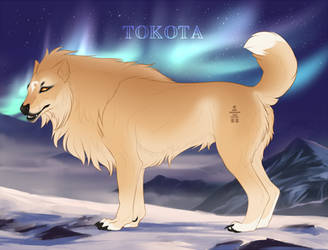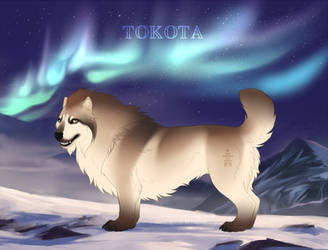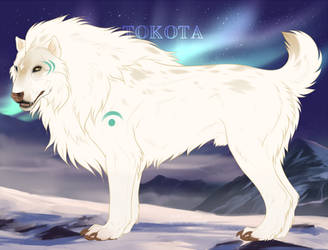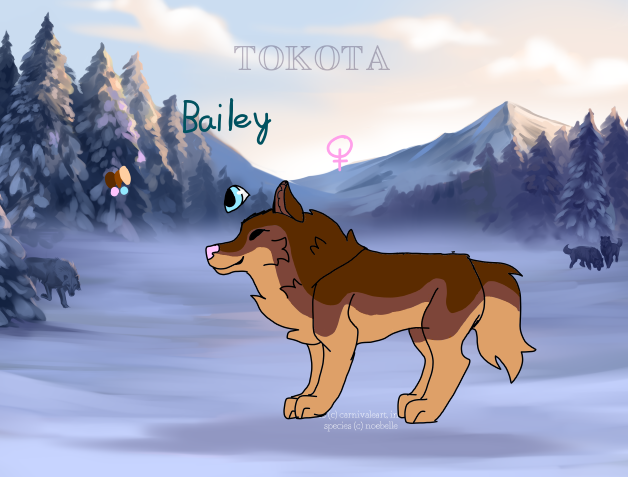This journal is out-of-date and no longer updated! Please check the
Species Information on Tokotna for current information!
Tokotas are not actually in the canine family. They are caniform, but are more closely related to bears.
Originating as an apex predator native to the wild tundra of the Arctic Circle, they are primarily carnivorous and mostly eat seals and fish. They have a very strong rivalry with bears, but grew a mutual respect with primitive humans that began their long domestication over the centuries.
The modern version of the of Tokota is far different from the prehistoric ancestor and only one of the original coat types — the "natural" type — remains. All other coat types were selectively bred into the species as a result of certain hair mutations.
On top of being used for early transportation, guard animals, and hunters, they were revered as a sacred animal and most commonly bear the significance of strong loyalty in primitive symbolism.
Normal Build Tokota
Canarctos venatori

- Height: Between 140 cm and 190 cm (the largest being wild-born)
- Weight: Ideal weight is 800-900 pounds, and largely depends on height
- Speed:
- Sprinting Speed: Roughly 100 km/h
- Running Speed: Roughly 75 km/h
- Loping Speed: 10-11 km/h
- Gait: Similar to the gait of a wolf, but a bit more heavy and lumbering like a bear. Usually a lope type gait, although capable of a trot, collected canter, Spanish walk, etc.
- Lifespan: 1-30 years in captivity, 28 on average. 12-15 years in the wild.
- Litter Size: 1-4 pups per litter
- Breeding Limits: Available breeding slots go up with hierarchy status. For more information check out Breeding Your Tokota.
- Breeding Facts:
- Tokotas reproduce using highly competitive courting rituals in the wild, and thus most domestic breedings are made with the use of AI (artificial insemination.)
- Tokotas have 1-4 pups in a litter, which will stay with the mother until a year of age.
- In the wild, the sire and the rest of the pack will participate in raising the pups, regardless of hierarchy status.
- Anatomy: Tokotas are most commonly perceived as being closest in appearance to a mixture of polar bears and wolves, though, they have a unique profile with an elegantly tapered snout, short and stocky claws, and hooked canine teeth for ice fishing. Their facial anatomy is far more angular than that of a wolf, and far more canine than that of a bear.
The neck, crest, and withers are protected by an insulating two inch layer of fat, and the fur consists of a dense underlayer with an exterior layer of guard hairs, which gives them a good resistance to the cold and harsh climate of the Arctic Circle. Fur may be shaved to prevent overheating in hotter climates.
Tokotas are well muscled with a deep chest and sloping back, and are extremely suitable for mounts. - Behavior: Attacks on people are very rare due to human influence on the breed, and in terms of domestication, Tokota are above horses, and very nearly close in docility to dogs and cats. While they have a wide range of utilities, they are also a popular choice as companions.
Tokota communicate most commonly in chuffs, growls, purrs, and long distance vocalizations consisting of deep, resonant howls, which fluctuate in pitch in a manner far more melodic than wolves or coyotes. Recent studies have shown that these are highly individual to specific packs and family groups.
Pups have a high pitched, chirpy bark, but will start to mimic howling around the age of six months.
Toki
Canarctos venatori

The affectionately termed "Toki" is not a subspecies as such, but is the result of a dwarfism mutation on a normal build tokota.
- Height: 75 cm (min) - 130cm (max)
- Weight: 400 lbs - 800 lbs
- Running Speed: Roughly 48 km/h
- Gait: Bouncy, slight waddle/saunter. They run similar to a corgi.
- Uses: Companion animals, but have a variety of show uses, including special Toki sled racing, beauty and costume contests, etc.
- Lifespan: 24-27 years on average.
- Litter Size: 1-4 pups per litter
- Breeding Limits: Tokis are limited to the same number of slots as normal Tokotas. They may crossbreed freely with standard Tokotas and the mutation has around a 10% chance of passing on to offspring. However at this time because of unknown health hazards and the preservation of dire blood, Tokotas with dwarfism cannot crossbreed with Dire built Tokotas.
- Anatomy: Tokis stand around a similar height to a medium-sized pony, and are roughly the same length as ordinary Tokotas. With this mutation, the legs are stubby, though the rest of the body remains well-proportioned.
- Behavior: Tokis bred to be companions and show animals have typically never interacted with a saddle or carried a rider, but generally have a very docile demeanor. Tokis arising out of normal parents may be more independent and/or aloof as they perhaps were not selectively bred for their behavior. Despite their size, they are very sociable and get along well with most other animals.
Tokis can be found in any breeding not involving a dire tokota with different amounts of success; all toki x toki pups will be tokis, but there is only a small chance with normal x normal breedings. They may also sometimes be tamed as wilds.
Dire Build Tokota
Canarctos dirus

The dire build is a subspecies of the more common Tokota, only recently discovered in a remote and isolated region of northern Nunavut.
- Height: 190 cm (min) - 210 cm (max)
- Weight: 1100 - 2000 lbs
- Running Speed: Roughly 56 km/h
- Gait: Heavy and weighted, a bit more lumbering than the normal Tokota
- Lifespan: 1-28 years in captivity, 24 on average. 1-5 years in the wild.
- Litter Size: 1-2 pups per litter
- Breeding Limits: Dires have much more limited breeding than normal tokotas. For more information check out Breeding Your Tokota.
- Anatomy: Much larger and muscular than the average Tokota, these beasts are huge. They are distinguished from their smaller counterparts by their size, dense coat, slightly roman profile, and short bushy tail.
- Behavior: Harder to handle than common build Tokotas, mostly because of their size and lack of domestication. Can be extremely dangerous due to the former. Training one requires extreme diligence, caution, and patience, but is genuinely rewarding. The domestication process is very selective, if a pup does not make the cut in terms of disposition, it may be released back into the wild or culled.
Dires can be obtained by either taming a wild one, breeding a normal x dire tokota, or a dire x dire tokota. For more information and percentages, check out
Breeding Your Tokota.
Akota Build
Canarctos akotas

- Height: 200 cm - 260 cm (max)
- Weight: 1500 lbs - 2500 lbs (max)
- Speed:
- Walk speed: 8km/hr
- Running speed: 40 km/hr
- Sprinting speed: 56 km/hr
- Gait: Slow and lumbering when walking, though they can quickly gather speed in a charge or sprint.
- Lifespan: 1-25 years in captivity, 20 on average. 1-50 years in the wild.
- Litter Size: 1 pup per litter. (1-2 pups per litter at Dominant & Alpha)
- Breeding Limits: Akotas can only breed with Dires or other Akotas. They cannot breed at all with standard build Tokotas or Tokis. Their offspring will therefore always be either a Dire or Akota build.
- Restrictions: Breedings are not affected by the Prestige Breeder faction bonus, Lavender, Fertility Supplements, Close Care, Swan, Hare, Fertility Roots, Akna's Presence or any other item or trait that would affect litter size.
- Anatomy: Akotas have far closer resemblance to bears than their Dire cousins - they have very large and broad shoulders, giving them a ‘hump-back’ appearance. Their fur is very dense and wiry. The pads of their feet are also more ursine than their smaller ancestors, with long toes and claws.
- Behavior: Extremely aggressive and territorial. Their huge size and primitive instincts make them extremely hard to handle, and more than a few handlers have lost their lives due to mishandling and the Akota’s quick attacks.





